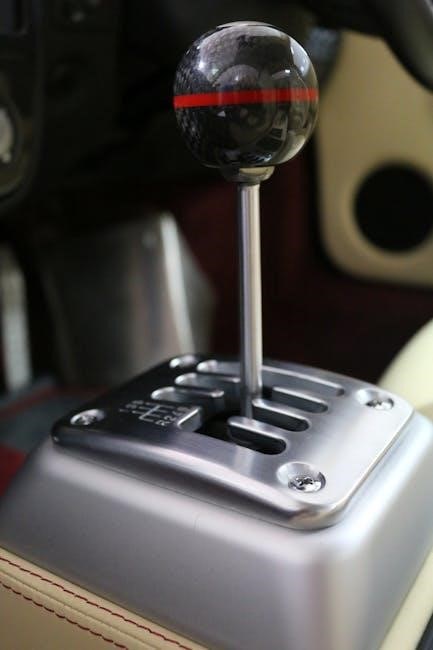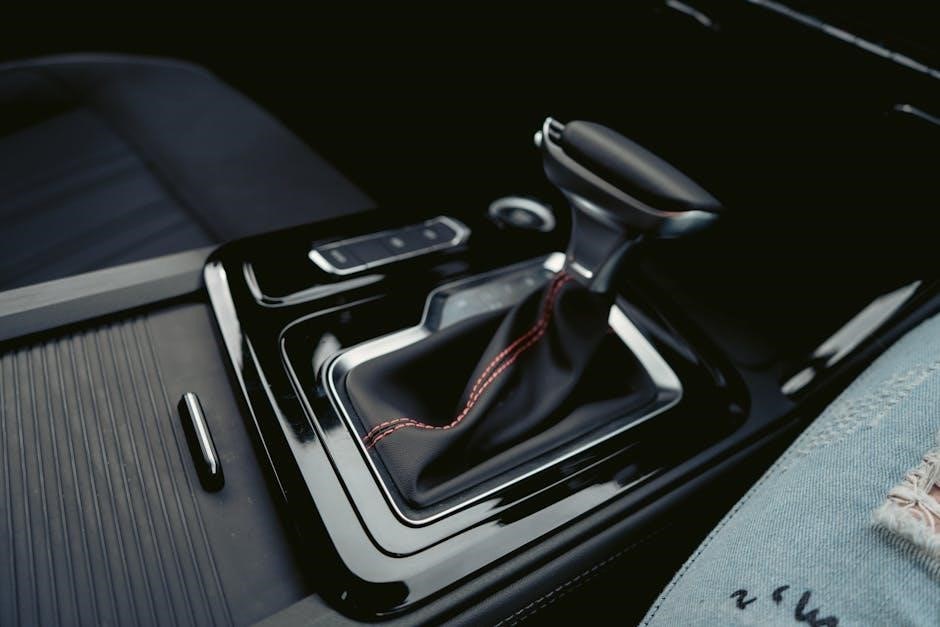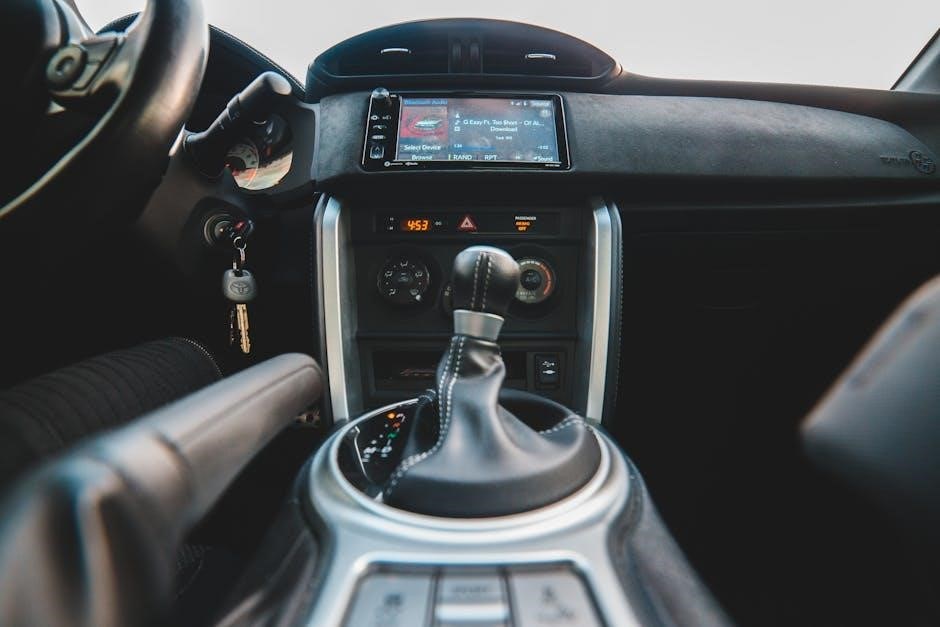manual transmission vs paddle shift
Manual transmissions offer driver engagement and fuel efficiency, requiring clutch operation and gear shifting․ Paddle shift transmissions provide convenience and ease, using electronic controls for seamless gear changes․
1․1 Overview of Manual Transmissions
A manual transmission, also known as a stick shift, requires the driver to manually change gears using a clutch pedal and gearshift․ This system provides direct control over the vehicle, offering improved fuel efficiency and a more engaging driving experience․ It is simpler in design compared to automatic or paddle shift transmissions, with fewer components and lower production costs․ Manual transmissions are often preferred by driving enthusiasts for their precision and connection to the vehicle’s performance, making them a popular choice for both everyday driving and high-performance applications․
1․2 Overview of Paddle Shift Transmissions
Paddle shift transmissions combine elements of manual and automatic systems, offering a semi-automatic experience․ They use paddle shifters on the steering wheel to manually change gears without a clutch pedal․ This design provides ease of use, especially in city driving, while maintaining some driver control․ Paddle shift transmissions are often found in high-performance vehicles, blending convenience with sporty handling․ They are ideal for drivers who want a balance between ease and engagement, making them a popular choice for modern vehicles seeking to enhance both practicality and driving enjoyment․
History and Evolution
Manual transmissions trace back to early automotive history, evolving from basic designs to modern, efficient systems․ Paddle shift transmissions emerged later, influenced by racing technology advancements․
2․1 The Development of Manual Transmissions
Manual transmissions originated in the early 20th century, evolving from basic, non-synchronized designs to modern, refined systems․ Early manuals required double-clutching, but the 1950s introduced synchromesh technology, reducing wear and improving shifting․ Over time, advancements in materials and design led to smoother, more efficient transmissions․ Today, manual transmissions are lighter, more durable, and offer better fuel efficiency, catering to both everyday drivers and enthusiasts seeking a connected driving experience․
2․2 The Emergence and Evolution of Paddle Shift Transmissions
Paddle shift transmissions emerged in the late 20th century, initially in racing, offering quick, clutch-less gear changes․ Early systems were bulky and expensive, but advancements in electronics and automation made them more accessible․ Modern paddle shifts use dual-clutch technology, combining the efficiency of manuals with the convenience of automatics․ These transmissions now feature in high-performance and luxury vehicles, blending driver control with seamless shifting, appealing to both enthusiasts and everyday drivers seeking a balance between performance and ease․
Key Components and Functionality
Manual transmissions rely on a clutch pedal, gearstick, and mechanical linkages, while paddle shifts use electronic controls and dual-clutch systems for automatic gear changes․
3․1 Drivetrain Components in Manual Transmissions
Manual transmissions consist of a clutch, gearbox, and gearstick․ The clutch disengages engine power, allowing manual gear shifts․ The gearbox houses gears and synchromesh for smooth transitions․ The gearstick connects to the gearbox, enabling driver control․ These components work together to provide precise, driver-initiated power delivery and torque management, essential for optimal performance and efficiency in various driving conditions․
3․2 Drivetrain Components in Paddle Shift Transmissions
Paddle shift transmissions utilize electronic controls and dual clutches for seamless gear changes․ The system includes paddle shifters, an electronic control unit, and a dual-clutch gearbox․ Sensors monitor driver input and engine data, optimizing shift timing․ The dual-clutch design enables rapid, automatic shifts without manual clutch operation, offering both performance and convenience․ This setup combines the efficiency of manual transmissions with the ease of automatics, providing a smooth and responsive driving experience․

Driver Engagement and Experience
Manual transmissions offer enhanced driver engagement through clutch and gear operation, requiring skill and attentiveness․ Paddle shift transmissions provide ease and convenience, appealing to drivers seeking simplicity․
4․1 Driver Engagement with Manual Transmissions
Manual transmissions foster a deeper connection between driver and vehicle, requiring active participation through clutch and gear operation․ This engagement enhances control and driving satisfaction, especially in dynamic scenarios․ The mechanical interaction demands skill and focus, making the driving experience more immersive․ For enthusiasts, the tactile feedback and ability to manually select gears provide a sense of mastery and enjoyment, elevating the overall driving pleasure․
4․2 Driver Engagement with Paddle Shift Transmissions
Paddle shift transmissions offer a balance of convenience and driver engagement, allowing for manual gear changes without a clutch․ This setup simplifies driving in heavy traffic while still providing control․ The ease of use appeals to those who want to enjoy driving dynamics without the complexity of a manual․ While it lacks the tactile feedback of a manual, paddle shifts enable quick, precise shifts, making them a practical choice for drivers seeking both comfort and sporty handling․
Performance and Efficiency
Manual transmissions traditionally excel in fuel efficiency and lightweight design, enhancing performance․ Paddle shift transmissions, while efficient, focus on seamless gear changes and responsive driving experiences․
5․1 Fuel Efficiency in Manual Transmissions
Manual transmissions are known for superior fuel efficiency due to their mechanical simplicity and driver control over gear shifts․ By allowing drivers to optimize engine speed and torque, manuals often achieve better mileage compared to automatics․ This is particularly beneficial in city driving, where frequent stops and starts can reduce efficiency․ Additionally, the absence of a torque converter minimizes energy loss, making manuals a cost-effective choice for eco-conscious drivers seeking to maximize fuel economy․
5․2 Fuel Efficiency in Paddle Shift Transmissions
Paddle shift transmissions offer impressive fuel efficiency, often rivaling manual transmissions, by utilizing advanced dual-clutch technology․ This system enables quick, seamless gear changes without significant energy loss․ Modern paddle shift systems are optimized for both performance and economy, especially in city driving where frequent acceleration and deceleration occur․ However, their efficiency can vary depending on driving style and specific design, sometimes falling slightly short of manual transmissions in real-world conditions due to added mechanical complexity․
Maintenance and Reliability
Manual transmissions are generally simpler and more reliable, requiring less maintenance than paddle shift systems․ Paddle shifts, while efficient, involve complex electronics, potentially increasing upkeep costs․
6․1 Maintenance Requirements for Manual Transmissions
Manual transmissions are relatively straightforward and durable, requiring less frequent maintenance compared to paddle shift systems․ Regular checks include clutch pedal adjustment, gear oil changes, and inspections for leaks․ The clutch, a key component, typically needs replacement every 50,000 to 100,000 miles, depending on driving habits․ Synchros and bearings may also require periodic servicing․ Proper maintenance ensures smooth shifting and prevents premature wear․ Timely replacements of worn parts can avoid costly repairs and extend the transmission’s lifespan, making manual transmissions a reliable choice for drivers․
6․2 Maintenance Requirements for Paddle Shift Transmissions
Paddle shift transmissions require more specialized maintenance compared to manual transmissions․ Regular software updates for the transmission control module are essential for optimal performance․ The dual-clutch system and hydraulic actuators need periodic inspections and fluid changes․ Sensors and electronic components must be checked for faults, and the clutch packs may require replacement more frequently depending on driving conditions․ Additionally, the transmission’s complex electronics necessitate professional diagnostics, making maintenance more costly and less DIY-friendly compared to manual transmissions․
Cost Considerations
Manual transmissions are generally more affordable to purchase and maintain․ Paddle shift transmissions, with their complex electronics, are typically more expensive upfront and in servicing costs․
7․1 Cost of Manual Transmissions
Manual transmissions are typically more affordable to purchase and maintain compared to paddle shift transmissions․ Their simpler design reduces production costs, making them a budget-friendly option․ Additionally, manual transmissions generally require less complex components, leading to lower repair and servicing expenses over time․ This cost-effectiveness, combined with their fuel efficiency, makes manual transmissions a popular choice for drivers seeking affordability without compromising performance․
7․2 Cost of Paddle Shift Transmissions
Paddle shift transmissions are generally more expensive than manual transmissions due to their advanced technology and complex components․ Their dual-clutch systems and electronic controls increase production costs, making them a higher-end option․ Additionally, maintenance and repairs for paddle shift transmissions can be more costly due to the specialized parts and expertise required․ While they offer enhanced driving convenience and performance, the higher price point makes them less accessible for budget-conscious drivers compared to manual transmissions․

Learning Curve and Accessibility
Manual transmissions require mastering the clutch and gear shifting, presenting a higher learning curve․ Paddle shift transmissions simplify driving by eliminating the clutch, enhancing accessibility for new drivers․
8․1 Learning to Drive a Manual Transmission
Mastering a manual transmission requires practice and coordination․ Drivers must learn to operate the clutch and gearshift smoothly, synchronizing pedal movements with acceleration․ Beginners often struggle with stalling, especially when starting uphill or in traffic․ Proper technique involves gradual clutch release while pressing the accelerator․ Starting in an empty parking lot is ideal for practice․ Over time, muscle memory develops, making shifting gears and controlling speed second nature․ Patience is key, as proficiency takes time and repetition to achieve․
8․2 Learning to Use Paddle Shift Transmissions
Using paddle shift transmissions is simpler than manual transmissions, requiring minimal driver input․ The electronic system handles clutch operation, allowing drivers to focus on steering and acceleration․ Paddles are typically located behind the steering wheel, enabling quick shifts without manual gear selection․ The learning curve is shorter, as drivers only need to understand when to use the paddles for upshifting or downshifting․ This ease of use makes paddle shift transmissions more accessible to new drivers or those who prefer a more streamlined driving experience without the complexity of a manual clutch․

Practicality in Various Driving Conditions
Manual transmissions excel in high-performance and control, while paddle shifts offer convenience in traffic․ Both suit different driving needs, from city commutes to racing scenarios․
9․1 Manual Transmissions in City Driving
Manual transmissions in city driving require frequent gear shifts and clutch operation, which can be tiring in heavy traffic․ However, they offer precise control and better fuel efficiency in stop-and-go conditions․ Drivers can optimize acceleration and deceleration, reducing wear on brakes․ While they demand more skill and attention, manuals often provide a more engaging urban driving experience compared to automatics․ For experienced drivers, manuals can be efficient and rewarding, but newcomers may find the constant shifting challenging․
9․2 Paddle Shift Transmissions in City Driving
Paddle shift transmissions offer convenience and ease in city driving, eliminating the need for a clutch pedal․ This reduces driver fatigue in heavy traffic and allows for smoother transitions between gears․ The electronic controls enable quick shifts without interrupting acceleration, making maneuvering through tight spaces easier․ However, paddle shifts may feel overly responsive in low-speed conditions, and their performance-oriented design might be less practical for urban commutes compared to traditional automatics․ Despite this, they provide a balance of comfort and control in stop-and-go driving scenarios․

Racing and High-Performance Applications
Racing and high-performance applications often favor manual transmissions for precise control and faster shifting․ Paddle shift transmissions, with their quick electronic actuation, are also popular in modern racing․
10․1 Manual Transmissions in Racing
In racing, manual transmissions are often preferred for their precision and control, allowing drivers to optimize gear shifts during high-speed maneuvers․ The physical engagement of using a clutch and gear lever provides a direct connection to the vehicle, enhancing driver feedback․ Manual transmissions are typically lighter and more reliable in extreme conditions, making them ideal for endurance and formula racing․ However, they require skill and focus, as incorrect shifting can lead to lost time or mechanical failure․ Despite advancements in paddle shift technology, many professional drivers still favor manual transmissions for their tactile driving experience and competitive edge․
10․2 Paddle Shift Transmissions in Racing
Paddle shift transmissions are increasingly popular in racing for their rapid gear changes and ease of use․ They eliminate the need for a clutch pedal, allowing drivers to focus on steering and braking․ Modern systems, like dual-clutch transmissions, offer near-instant shifts, enhancing acceleration and lap times․ Paddle shifts are particularly advantageous in high-speed cornering, where manual shifting might be disruptive․ Their reliability and consistency make them ideal for endurance races, though some drivers argue they lack the tactile feedback of manual transmissions, which can be a drawback in certain racing scenarios․
Common Issues and Solutions
Manual transmissions often face clutch wear and gear grinding, solved by adjusting driving techniques and replacing worn parts․ Paddle shifts may experience electronic glitches, requiring software updates or sensor replacements․
11․1 Common Issues with Manual Transmissions
Manual transmissions often experience issues like worn clutches, gear grinding, and synchronizer problems․ Clutch wear occurs from excessive riding or sudden disengagement․ Gear grinding results from improper shifting techniques or misalignment․ Synchronizer damage can happen due to aggressive driving or high mileage․ Regular maintenance, such as clutch adjustments and fluid checks, can prevent these issues․ Replacing worn components and refining driving habits are common solutions to extend transmission lifespan and ensure smooth operation․
11․2 Common Issues with Paddle Shift Transmissions
Paddle shift transmissions can experience electronic failures, software glitches, and high maintenance costs․ Issues often arise from faulty sensors, wiring, or solenoid malfunctions․ Overheating in racing conditions can damage components․ Additionally, wear on clutches and gearboxes over time may require costly replacements․ Regular maintenance, such as fluid changes and software updates, helps prevent these problems․ Despite advancements, paddle shift systems remain more complex and expensive to repair compared to manual transmissions, making them less accessible for some drivers․
Technological Advancements
Modern manual transmissions feature lightweight materials and optimized gear ratios for better performance․ Paddle shift systems now include advanced software for faster shifts and dual-clutch designs for seamless operation․
12․1 Modern Advancements in Manual Transmissions
Modern manual transmissions have evolved with lightweight materials and optimized gear ratios, enhancing fuel efficiency and performance․ Advanced synchronizers reduce shifting effort, while torque-vectoring technologies improve traction․ Electronic controls now integrate with engines for smoother operation, and some models feature automatic rev-matching for downshifts, reducing wear on components․ These innovations maintain the driving engagement of manuals while addressing past limitations, making them more accessible and reliable than ever before․
12․2 Modern Advancements in Paddle Shift Transmissions
Paddle shift transmissions now feature dual-clutch systems for faster, smoother gear changes․ Advanced electronic controls optimize shifting based on driver input and road conditions․ Integration with AI and predictive systems enhances efficiency, while lightweight materials improve fuel economy․ Some systems offer manual override for driver engagement, blending automation with control․ These advancements ensure paddle shift transmissions deliver high performance, convenience, and reliability, catering to both everyday drivers and enthusiasts alike․
Environmental Impact
Manual transmissions often offer better fuel efficiency, reducing emissions․ Paddle shift systems, while convenient, may consume more fuel due to their complex electronic components and weight․
13․1 Environmental Impact of Manual Transmissions
Manual transmissions typically offer better fuel efficiency, reducing greenhouse gas emissions․ Their simplicity and lighter weight contribute to lower energy consumption and environmental impact compared to automatic systems․
13․2 Environmental Impact of Paddle Shift Transmissions
Paddle shift transmissions, while efficient, often feature advanced technology that can reduce fuel consumption․ However, their complexity and weight may offset some environmental benefits․ These systems typically maintain optimal gear ratios, enhancing efficiency, but their production and reliance on electronic components can have a larger environmental footprint․ Overall, paddle shift transmissions balance performance with moderate environmental impact, though they may not be as eco-friendly as manual transmissions in certain driving conditions․
Market Trends and Consumer Preferences
Manual transmissions are declining in popularity, while paddle shift transmissions are gaining traction in high-performance vehicles․ Consumers increasingly favor convenience, though driving enthusiasts still value manual control․
14․1 Market Trends for Manual Transmissions
Manual transmissions are becoming less popular globally, with fewer models offering them․ However, niche markets, such as sports cars and enthusiast vehicles, still see strong demand․ Automakers are refining manual systems to enhance performance and efficiency, appealing to purists․ Despite declining sales, manuals remain a symbol of driving engagement, attracting a loyal customer base․ The trend reflects a shift toward convenience, yet manuals hold a special place in automotive culture․
14․2 Market Trends for Paddle Shift Transmissions
Paddle shift transmissions are gaining popularity, especially in high-performance and luxury vehicles․ Their seamless integration with modern technology, such as dual-clutch systems, enhances efficiency and driver convenience․ The demand is driven by consumers seeking a balance between automation and control․ Additionally, the rise of semi-autonomous and electric vehicles has accelerated their adoption․ Paddle shift systems are increasingly standard in premium models, catering to tech-savvy and performance-oriented buyers․ This trend reflects a shift toward innovative, driver-centric solutions while maintaining the practicality of automatic transmissions․
Manual and paddle shift transmissions cater to different preferences, balancing engagement, efficiency, and convenience․ The choice depends on driving style, lifestyle, and personal priorities, ensuring optimal performance and satisfaction․
15․1 Which Transmission Type is Better for You?
Choosing between manual and paddle shift transmissions depends on personal preferences, driving habits, and lifestyle․ Manuals offer cost-effectiveness, fuel efficiency, and a more engaging driving experience, appealing to enthusiasts who enjoy control․ Paddle shifts provide ease of use, convenience in traffic, and smoother automation, ideal for those prioritizing comfort․ Consider factors like budget, daily driving conditions, and desired performance to decide which transmission aligns best with your needs and preferences for an optimal driving experience․
15․2 The Future of Manual and Paddle Shift Transmissions
The future of transmissions is evolving with technological advancements․ Manuals are becoming niche, favored by enthusiasts, while paddle shifts and automatics are gaining popularity due to convenience and integration with hybrid and electric vehicles․ Automakers are refining dual-clutch and CVT systems for better efficiency and performance․ As automotive technology progresses, both transmission types will adapt, with manuals likely remaining for performance cars and paddle shifts dominating mainstream markets, offering a blend of innovation and driver preference․

